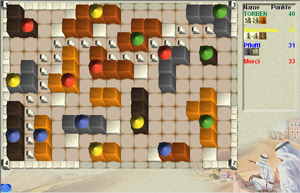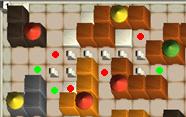Medina
Medina (Originalregel)
Game preparation
With /join can enter 3-4 players into the game. With /start the game begins. Alternatively, you can use the game management use.
The game

Players rebuild the disintegrated city of Medina. They form palaces in four colors. The streets are revived through the Marktgasse and around the old town the city wall is rebuilt.
Medina is implemented in the BrettspielWelt according to the special rules of the DM 2003. A few subtleties are played here differently than in the original rule.
Game sequence
Material
| Players | Palace components in 4 colors | Goat | Market street figures | Walls | roofs |
|---|---|---|---|---|---|
| 3 | 6 | 4 | 8 | 10 | 4 |
| 4 | 5 | 3 | 6 | 8 | 4 |
Construction

The starter must first select the starting point of the Marktgasse. It clicks on a building site that is not on the edge. Each player then uses two components per train.
Palace components

Palace parts of an unexisting colour may be installed in any free places. Available colors must be always be cultivated until either a player puts a roof on this palace or is no longer expandable. Then a new one can be founded.

Palestinians may never to be connected either diagonally or through goats; i.e. around a palace, at least one field must always remain free (marked in the image by the black points around the orange palace).
Goat

Goat trunks are cultivated directly on palaces. In contrast to components, they may also be placed on a palace if it already has a roof.
Market lane

The market lane figures must always be attached to the existing market lane in such a way that each newly inserted figure has exactly one neighbour (not diagonal). So you can't build closed circles with it. The market gate may: No Own branches! If the Marktgasse is no longer expandable, it may be re-established at any location (also on the edge!). Attention: this can decide a game. There the same rules apply again.

In the picture, the currently allowed setting points are marked green, no figure can be set at the red points.
Walls

Walls are built from the corners along the edge. They must always be attached to an existing wall or a corner tower. Two towers must never be connected to each other, i.e. a gap (city gate) must always remain between two walls that run towards each other.
roofs

The roofs are placed on palaces. Each player must take exactly one palace of each color. If only one player has roofs, he must put at least one roof every time he is on the row. For this purpose, he must also establish appropriate palaces.
Outputting components

Once each player has taken possession of a palace from a color (in the picture the gray palaces) or no component of this color fits on the schedule, all other stones of this color must be delivered. This shortens the game, which can be a disadvantage for players who have to give too many components.
Rare exception: if you only have goat's stalls that are not to be set anywhere, but other players could start a palace in the further course of the game where this goat's stall would be usable, you will use this train.
Playing
The game ends when the last player has installed his last part. Players who give something might play shorter. This can be a decisive disadvantage in extra cages (see classification). A no longer to be built goat shed remains.
Value
- Each component in the palace brings a point (colored palace parts and goat's trunks).
- Each market street figure bordering directly (not diagonally) to a palace or goat's stable brings a point.
- Each wall that borders directly to a palace or goat's stable brings a point.

Examples:
The gray palace with the green roof top right gets 11 points: 4 (colored palace parts) + 2 (market lane) + 5 (mour)
The black palace of blue left below gets 13 points: 4 (colored palace parts) + (Marktgasse) + 5 (Mauern)
The orange palace with a red roof gets 11 points: 4 (coloured palace parts) + 2 (column) + 5 (market lane: 3 at the palace, 2 at the two stables)
The orange palace with green roof right below gets 8 points: 5 (colored palace parts) + 2 (column) + 1 (column adjacent to the stable)
There are also eight bonus cards: four for each palace color, four for the corner towers.
The palace bonus cards are awarded at the moment when the first player finishes a palace of the corresponding color. If another player creates a larger palace of the same color, the bonus card changes.
Goat trunks naturally count when calculating the palace size.
The bonus cards for the corner towers receive the player who first closes a palace with a wall part to one of the towers. The bonus card continues to migrate to the player who has recently joined a palace with a wall piece to a corner tower.

The white maps stand for the corner towers, the colored ones for the corresponding palace color.
The player with the greatest gray/black/brown/orange palace gets 1/2/3/4 bonus points.
The player who recently joined a palace to the wall running from the tower in corner 1/2/3/4 gets 1/2/3/4 points.
Each edge of the wall counts as a new connection (respect: different from the original rule!). A palace is set by a roof on the wall new connected. A subsequent insertion of a goat's stable can also lead to a new connection.

